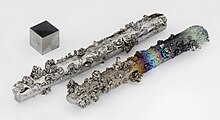ᱴᱟᱸᱜᱟᱥᱴᱟᱱ
 | |||||||||||||||||||||||||||||||||||||||||
| Tungsten | |||||||||||||||||||||||||||||||||||||||||
|---|---|---|---|---|---|---|---|---|---|---|---|---|---|---|---|---|---|---|---|---|---|---|---|---|---|---|---|---|---|---|---|---|---|---|---|---|---|---|---|---|---|
| Pronunciation | /ˈtʌŋstən/ | ||||||||||||||||||||||||||||||||||||||||
| Alternative name | wolfram, pronounced: /ˈwʊlfrəm/ (WUUL-frəm) | ||||||||||||||||||||||||||||||||||||||||
| Appearance | grayish white, lustrous | ||||||||||||||||||||||||||||||||||||||||
| Standard atomic weight Ar, std(W) | 183.84(1)[᱑] | ||||||||||||||||||||||||||||||||||||||||
| Tungsten in the periodic table | |||||||||||||||||||||||||||||||||||||||||
| |||||||||||||||||||||||||||||||||||||||||
| Atomic number (Z) | 74 | ||||||||||||||||||||||||||||||||||||||||
| Group | group 6 | ||||||||||||||||||||||||||||||||||||||||
| Period | period 6 | ||||||||||||||||||||||||||||||||||||||||
| Block | d-block | ||||||||||||||||||||||||||||||||||||||||
| Element category | Transition metal | ||||||||||||||||||||||||||||||||||||||||
| Electron configuration | [Xe] 4f14 5d4 6s2[᱒] | ||||||||||||||||||||||||||||||||||||||||
Electrons per shell | 2, 8, 18, 32, 12, 2 | ||||||||||||||||||||||||||||||||||||||||
| Physical properties | |||||||||||||||||||||||||||||||||||||||||
| Phase at STP | solid | ||||||||||||||||||||||||||||||||||||||||
| Melting point | 3695 K (3422 °C, 6192 °F) | ||||||||||||||||||||||||||||||||||||||||
| Boiling point | 6203 K (5930 °C, 10706 °F) | ||||||||||||||||||||||||||||||||||||||||
| Density (near r.t.) | 19.3 g/cm3 | ||||||||||||||||||||||||||||||||||||||||
| when liquid (at m.p.) | 17.6 g/cm3 | ||||||||||||||||||||||||||||||||||||||||
| Heat of fusion | 52.31 kJ/mol[᱓][᱔] | ||||||||||||||||||||||||||||||||||||||||
| Heat of | 774 kJ/mol | ||||||||||||||||||||||||||||||||||||||||
| Molar heat capacity | 24.27 J/(mol·K) | ||||||||||||||||||||||||||||||||||||||||
pressure
| |||||||||||||||||||||||||||||||||||||||||
| Atomic properties | |||||||||||||||||||||||||||||||||||||||||
| Oxidation states | −4, −2, −1, 0, +1, +2, +3, +4, +5, +6 (a mildly acidic oxide) | ||||||||||||||||||||||||||||||||||||||||
| Electronegativity | Pauling scale: 2.36 | ||||||||||||||||||||||||||||||||||||||||
| energies |
| ||||||||||||||||||||||||||||||||||||||||
| Atomic radius | empirical: 139 pm | ||||||||||||||||||||||||||||||||||||||||
| Covalent radius | 162±7 pm | ||||||||||||||||||||||||||||||||||||||||
| Other properties | |||||||||||||||||||||||||||||||||||||||||
| Natural occurrence | primordial | ||||||||||||||||||||||||||||||||||||||||
| Crystal structure | (bcc) | ||||||||||||||||||||||||||||||||||||||||
| Speed of sound thin rod | 4620 m/s (at r.t.) (annealed) | ||||||||||||||||||||||||||||||||||||||||
| Thermal expansion | 4.5 µm/(m·K) (at 25 °C) | ||||||||||||||||||||||||||||||||||||||||
| Thermal conductivity | 173 W/(m·K) | ||||||||||||||||||||||||||||||||||||||||
| Electrical resistivity | 52.8 nΩ·m (at 20 °C) | ||||||||||||||||||||||||||||||||||||||||
| Magnetic ordering | paramagnetic[᱕] | ||||||||||||||||||||||||||||||||||||||||
| Magnetic susceptibility | +59.0·10−6 cm3/mol (298 K)[᱖] | ||||||||||||||||||||||||||||||||||||||||
| Young's modulus | 411 GPa | ||||||||||||||||||||||||||||||||||||||||
| Shear modulus | 161 GPa | ||||||||||||||||||||||||||||||||||||||||
| Bulk modulus | 310 GPa | ||||||||||||||||||||||||||||||||||||||||
| Poisson ratio | 0.28 | ||||||||||||||||||||||||||||||||||||||||
| Mohs hardness | 7.5 | ||||||||||||||||||||||||||||||||||||||||
| Vickers hardness | 3430–4600 MPa | ||||||||||||||||||||||||||||||||||||||||
| Brinell hardness | 2000–4000 MPa | ||||||||||||||||||||||||||||||||||||||||
| CAS Number | 7440-33-7 | ||||||||||||||||||||||||||||||||||||||||
| History | |||||||||||||||||||||||||||||||||||||||||
| Discovery | Carl Wilhelm Scheele (1781) | ||||||||||||||||||||||||||||||||||||||||
| First isolation | Juan José Elhuyar and Fausto Elhuyar (1783) | ||||||||||||||||||||||||||||||||||||||||
| Named by | Torbern Bergman (1781) | ||||||||||||||||||||||||||||||||||||||||
| Main isotopes of tungsten | |||||||||||||||||||||||||||||||||||||||||
| |||||||||||||||||||||||||||||||||||||||||
ᱴᱟᱸᱜᱟᱥᱴᱟᱱ (tungsten) ᱥᱮ ᱣᱚᱞᱯᱷᱨᱟᱢ (wolfram) ᱟᱮᱚᱨᱛ ᱥᱟᱨᱱᱤ ᱨᱮᱱᱟᱜ ᱛᱩᱨᱩᱭ ᱟᱜ ᱚᱸᱛᱚᱨᱣᱚᱨᱛᱤ (transition group) ᱨᱮᱱᱟᱜ ᱤᱞᱤᱢᱮᱸᱴ ᱠᱟᱱᱟ᱾ ᱡᱟᱣ ᱟᱵᱚᱥᱛᱟ ᱨᱮᱫᱚ ᱱᱚᱶᱟ ᱨᱮᱱᱟᱜ ᱥᱛᱷᱟᱭᱤ ᱥᱚᱢᱚᱥᱛᱷᱟᱱᱤᱠ ᱧᱟᱢ ᱦᱩᱭ ᱟᱠᱟᱱᱟ, ᱡᱟᱦᱟᱸ ᱫᱚ ᱱᱚᱶᱟ ᱨᱮᱱᱟᱜ ᱦᱟᱢᱟᱞ ᱥᱮ ᱫᱨᱚᱣᱭᱚᱢᱟᱱ ᱮᱞᱮᱞ ᱑᱘᱐, ᱑᱘᱒, ᱑᱘᱓, ᱑᱘᱔, ᱟᱨ ᱑᱘᱗ ᱠᱟᱱᱟ᱾ ᱱᱚᱶᱟ ᱠᱷᱚᱱ ᱮᱴᱟᱜ ᱑᱘᱑, ᱑᱘᱕, ᱟᱨ ᱑᱙᱗ ᱫᱨᱚᱣᱭᱚᱢᱟᱱ ᱮᱞᱮᱞ ᱨᱮᱱᱟᱜ ᱛᱮᱥᱤᱭᱚ ᱫᱷᱚᱨᱢᱤ ᱥᱚᱢᱚᱥᱛᱷᱟᱱᱤᱠ ᱠᱨᱤᱛᱨᱤᱢ ᱥᱟᱫᱷᱟᱱ ᱛᱮ ᱵᱟᱱᱟᱣ ᱦᱩᱭ ᱟᱠᱟᱱᱟ᱾
᱑᱘ ᱜᱟᱱ ᱥᱟᱛᱟᱵᱟᱫᱤ ᱦᱟᱹᱵᱤᱡ ᱴᱟᱸᱜᱟᱥᱴᱟᱱ ᱨᱮᱱᱟᱜ ᱟᱭᱥᱟᱠ ᱴᱤᱱ ᱨᱮ ᱜᱮ ᱭᱚᱜᱤᱠ ᱢᱟᱱᱟᱜ ᱠᱟᱱᱟ᱾ ᱑᱗᱘᱑ ᱨᱮ ᱥᱮᱞᱮ (Scheele) ᱱᱟᱢᱟᱠ ᱥᱟᱬᱮᱤ ᱠᱚ ᱱᱚᱶᱟ ᱠᱚ ᱥᱤᱫᱷ ᱟᱠᱟᱫᱟ ᱡᱮ ᱱᱚᱶᱟ ᱨᱮᱱᱟᱜ ᱟᱭᱥᱟᱠ ᱨᱮ ᱱᱚᱣᱤᱱ ᱮᱥᱤᱰ ᱱᱤᱛᱟᱝ ᱨᱮ ᱢᱮᱱᱟᱜᱼᱟ, ᱡᱟᱦᱟᱸ ᱫᱚ ᱚᱱᱟ ᱴᱟᱸᱜᱟᱥᱴᱟᱱ ᱮᱥᱤᱰ ᱠᱚ ᱢᱮᱛᱟᱣᱟᱜᱼᱟ᱾ ᱱᱚᱶᱟ ᱛᱟᱭᱚᱢ ᱫᱷᱟᱹᱛᱩ ᱛᱭ ᱱᱚᱶᱟ ᱮᱥᱤᱰ ᱨᱮᱱᱟᱜ ᱵᱟᱱᱟᱣ ᱛᱮ ᱦᱚᱸ ᱯᱩᱥᱴᱤ ᱦᱩᱭ ᱟᱠᱟᱱᱟ᱾ ᱱᱚᱶᱟ ᱛᱟᱛᱣᱚ ᱨᱮᱱᱟᱜ ᱵᱟᱨᱭᱟ ᱟᱥᱚᱞ ᱟᱭᱥᱟᱠ ᱢᱮᱱᱟᱜᱼᱟ : ᱥᱮᱞᱟᱭᱤᱴ (Scheelite) ᱟᱨ ᱣᱚᱞᱯᱷᱨᱟᱢᱟᱭᱤᱴ (wolframite) ᱾ ᱥᱮᱞᱟᱭᱤᱴ ᱟᱭᱥᱟᱠ ᱟᱥᱚᱞ ᱛᱮ - ᱠᱮᱞᱥᱤᱭᱟᱢ, (CaWO4), ᱛᱟᱦᱮᱱ ᱠᱟᱱᱟ ᱟᱨ ᱣᱚᱞᱯᱷᱨᱟᱢᱟᱭᱤᱴ ᱨᱮ ᱞᱚᱦ ᱟᱨ ᱢᱮᱹᱜᱽᱱᱤᱡᱽ ᱴᱟᱸᱜᱽᱥᱴᱮᱴ, (FeWO4. MnWO4), ᱨᱮᱱᱟᱜ ᱥᱚᱸᱢᱤᱥᱨᱚᱱ ᱛᱟᱦᱮᱱ ᱠᱟᱱᱟ᱾ ᱴᱟᱸᱜᱟᱥᱴᱟᱱ ᱨᱮᱱᱟᱜ ᱟᱥᱚᱞ ᱮᱛᱚᱭ ᱵᱚᱨᱢᱟ, ᱪᱤᱱ, ᱡᱟᱯᱟᱱ, ᱵᱚᱞᱤᱵᱷᱤᱭᱟ, ᱥᱟᱶ ᱯᱚᱱᱚᱛ ᱟᱢᱮᱨᱤᱠᱟ ᱟᱨ ᱚᱥᱴᱨᱮᱞᱤᱭᱟ᱾
ᱴᱟᱸᱜᱟᱥᱴᱟᱱ ᱟᱭᱥᱟᱠ ᱫᱚ ᱥᱚᱸᱫᱨᱤᱛ ᱠᱟᱛᱮᱜ ᱥᱚᱰᱤᱭᱟᱢ ᱠᱟᱨᱵᱚᱱᱮᱴ, (Na2CO3), ᱥᱟᱶ ᱥᱮᱞᱮᱫ ᱢᱮᱥᱟ ᱠᱟᱛᱮᱜ ᱵᱚᱫᱚᱞ ᱵᱷᱨᱲᱥᱴᱨᱚ ᱨᱮ ᱞᱟᱜᱽᱵᱷᱟᱜᱽ ᱑᱐,᱐᱐᱐ ᱥᱮ ᱦᱟᱹᱵᱤᱡ ᱞᱚᱞᱚ ᱦᱩᱭᱩᱜ ᱠᱟᱱᱟ᱾ ᱱᱚᱶᱟ ᱠᱟᱹᱢᱤ ᱛᱮ ᱥᱚᱰᱤᱭᱟᱢ ᱴᱟᱸᱜᱟᱥᱴᱮᱴ (Na2WO4), ᱵᱟᱱᱟᱜ ᱠᱟᱱᱟ ᱟᱨ ᱞᱚᱦ, ᱢᱮᱸᱜᱱᱤᱡᱽ ᱮᱢᱟᱱ ᱠᱚ ᱟᱯᱱᱟᱨ ᱠᱟᱨᱵᱚᱱᱮᱴ ᱨᱮ ᱵᱚᱫᱚᱞᱚᱜ ᱦᱩᱭᱩᱜ ᱠᱟᱱᱟ᱾ ᱥᱚᱰᱤᱭᱟᱢ ᱴᱟᱸᱜᱟᱥᱴᱮᱴ ᱞᱚᱞᱚ ᱫᱟᱜ ᱨᱮ ᱵᱤᱞᱮᱭ ᱦᱩᱭᱩᱜ ᱠᱟᱱᱟ ᱟᱨ ᱱᱟᱶᱟ ᱞᱮᱠᱟᱱ ᱥᱚᱸᱢᱤᱥᱨᱚᱱ ᱠᱷᱚᱱ ᱡᱩᱫᱟ ᱫᱟᱜ ᱨᱮ ᱵᱤᱞᱮᱭ ᱚᱜ ᱠᱟᱱᱟ᱾ ᱟᱱᱟ ᱛᱟᱭᱱᱚᱢ ᱩᱵᱽᱞᱟᱹᱣ ᱞᱮᱠᱷᱟᱱ ᱦᱟᱭᱰᱨᱚᱠᱞᱚᱨᱤᱠ ᱮᱥᱤᱰ, ᱦᱟᱠᱞᱚ (HCl), ᱨᱮᱱᱟᱜ ᱠᱟᱹᱢᱤ ᱛᱮ ᱴᱟᱸᱜᱟᱥᱴᱟᱱ ᱮᱥᱤᱰ ᱟᱣᱪᱷᱮᱯᱤᱛ ᱦᱩᱭ ᱫᱟᱲᱮᱭᱟᱜ ᱟ, ᱡᱟᱦᱟᱸ ᱫᱚ ᱨᱚᱦᱚᱲ ᱠᱟᱛᱮᱜ ᱡᱩᱞ ᱞᱟᱹᱜᱤᱫ ᱛᱮ ᱥᱟᱥᱟᱝ ᱟᱣᱪᱷᱮᱯᱤᱛ ᱦᱩᱭ ᱦᱩᱭ ᱫᱟᱲᱮᱭᱟᱜ ᱟ, ᱡᱟᱦᱟᱸ ᱫᱚ ᱨᱚᱦᱚᱲ ᱠᱟᱛᱮᱜ ᱡᱩᱸᱰᱤ ᱞᱟᱹᱜᱤᱫ ᱛᱮ ᱥᱟᱥᱟᱝ ᱨᱚᱝ ᱨᱮᱱᱟᱜ ᱴᱟᱸᱜᱟᱥᱴᱟᱱ ᱚᱠᱥᱟᱭᱤᱰ (WO2), ᱧᱟᱢᱚᱜ ᱠᱟᱱᱟ᱾ ᱦᱟᱭᱰᱨᱚᱡᱟᱱ ᱛᱮ ᱚᱠᱥᱟᱭᱤᱰ ᱨᱮᱱᱟᱜ ᱟᱣᱠᱟᱨᱟᱱ ᱠᱷᱚᱱ ᱴᱟᱸᱜᱟᱥᱴᱟᱱ ᱫᱷᱟᱛᱩ ᱥᱟᱯᱲᱟᱣ ᱟᱠᱟᱱᱟ᱾
ᱱᱚᱸᱰᱮ ᱦᱚᱸ ᱧᱮᱞᱢᱮ
[ᱥᱟᱯᱲᱟᱣ | ᱯᱷᱮᱰᱟᱛ ᱥᱟᱯᱲᱟᱣ]ᱥᱟᱹᱠᱷᱭᱟᱹᱛ
[ᱥᱟᱯᱲᱟᱣ | ᱯᱷᱮᱰᱟᱛ ᱥᱟᱯᱲᱟᱣ]- ↑ Meija, Juris; Coplen, Tyler B.; Berglund, Michael; Brand, Willi A.; De Bièvre, Paul; Gröning, Manfred; Holden, Norman E.; Irrgeher, Johanna; Loss, Robert D.; Walczyk, Thomas; Prohaska, Thomas (2016). "Atomic weights of the elements 2013 (IUPAC Technical Report)". Pure and Applied Chemistry. 88 (3): 265–91. doi:10.1515/pac-2015-0305.
{{cite journal}}: Unknown parameter|displayauthors=ignored (help) - ↑ Berger, Dan. "Why does Tungsten not 'Kick' up an electron from the s sublevel ?". Bluffton College, USA.
- ↑ Lide, David R., ed. (2009). CRC Handbook of Chemistry and Physics (90th ed.). Boca Raton, Florida: CRC Press. p. 6-134. ISBN 978-1-4200-9084-0.
- ↑ Tolias P. (2017). "Analytical expressions for thermophysical properties of solid and liquid tungsten relevant for fusion applications". Nuclear Materials and Energy. 13: 42–57. arXiv:1703.06302. Bibcode:2017arXiv170306302T. doi:10.1016/j.nme.2017.08.002.
- ↑ Lide, D. R., ed. (2005). "Magnetic susceptibility of the elements and inorganic compounds" (PDF). CRC Handbook of Chemistry and Physics (86th ed.). Boca Raton (FL): CRC Press. ISBN 978-0-8493-0486-6.
- ↑ Weast, Robert (1984). CRC, Handbook of Chemistry and Physics. Boca Raton, Florida: Chemical Rubber Company Publishing. p. E110. ISBN 978-0-8493-0464-4.
- ↑ Berger, Dan (February 25, 2000). "Why does Tungsten not 'Kick' up an electron from the s sublevel ?". Bluffton College, USA.


